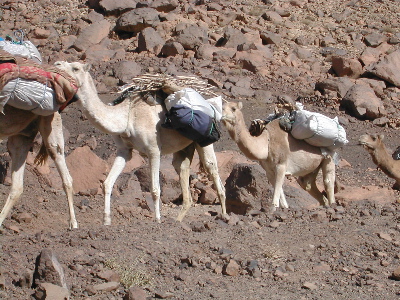ERROR : Server Busy(-1105)
ERROR : Server Busy(-1105)
Dromedary Camel (Camelus dromedarius) - Wiki
Dromedary
From Wikipedia, the free encyclopedia
[Photo] menare Alg??rie. Photo by Florence Devouard.
The Dromedary Camel (Camelus dromedarius) (sometimes referred to simply as the "dromedary") is a large even-toed ungulate native to northern Africa and western Asia, and is the best-known member of the camel family. The dromedary camel has one hump on its back, in contrast to the Bactrian Camel which has two. The dromedary is sometimes called an Arabian Camel. Some maintain that the name "dromedary" should be used to refer only to racing camels. To quote the Oakland Zoo's website,
The name "Dromedary" is properly reserved for the Arabian racing camel such as those used in the various military camel corps.
Originally native to western Asia, dromedaries were first domesticated in central or southern Arabia some thousands of years ago. Experts are divided regarding the date: some believe it was around 4000 BCE, others as recently as 1400 BCE. There are currently almost 13 million domesticated dromedaries, mostly in the area from Western India via Pakistan through Iran to northern Africa. None survive in the wild in their original range, although the escaped population of Australian feral camels number about 300,000. Around the second millennium BCE, the dromedary was introduced to Egypt and North Africa.
Although there are several other camelids, the only other surviving species of true camel today is the Bactrian Camel. The Bactrian camel was domesticated sometime before 2500 BCE in Asia, well after the earliest estimates for the dromedary. The Bactrian camel is a stockier, hardier animal, being able to survive from Iran to the Tibet [3]. The dromedary is taller and faster: with a rider they can maintain 8-9 mph for hours at a time. By comparison, a loaded Bactrian camel moves at about 2.5 mph [4].
Around the second millennium BCE, camels became established to the Sahara region but disappeared again from the Sahara beginning around 900 BCE. The Persian invasion of Egypt under Cambyses introduced domesticated camels to the area. Domesticated camels were used through much of North Africa, and the Romans maintained a corps of camel warriors to patrol the edge of the desert. The Persian camels, however, were not particularly suited to trading or travel over the Sahara; rare journeys made across the desert were made on horse-drawn chariots.
The stronger and more durable Bactrian Camels first began to arrive in Africa in the fourth century. It was not until the Islamic conquest of North Africa, however, that these camels became common. While the invasion was accomplished largely on horseback, the new links to the Middle East allowed camels to be imported en masse. These camels were well-suited to long desert journeys and could carry a great deal of cargo. For the first time this allowed substantial trade over the Sahara.
Male dromedaries have a soft palate, which they inflate to produce a deep pink sack, called a doula in Arabic, hanging out of the sides of their mouth to attract females during the mating season. Dromedaries are also noted for their thick eyelashes and small, hairy ears.
Gestation in the dromedary lasts around 12 months. Usually a single calf is born, and nursed for up to 18 months. Females are sexually mature after 3 to 4 years, males after 5 to 6 years. Lifespan in captivity is typically about 25 years, with some animals reaching the age of 50.
Adults grow to a length of 10 feet and height of six to seven feet. Weight is usually in the range of 1000-1500 pounds.
Modern domesticated dromedaries are used for milk and meat and as beasts of burden for cargo and passengers. Unlike horses, they kneel for the loading of passengers and cargo. At many of the desert located tourist sites in Egypt, mounted police on camels can be seen.
http://en.wikipedia.org/wiki/Dromedary
| The text in this page is based on the copyrighted Wikipedia article shown in above URL. It is used under the GNU Free Documentation License. You may redistribute it, verbatim or modified, providing that you comply with the terms of the GFDL. |
|

